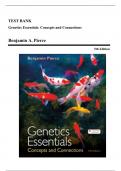Exam (elaborations)
Test Bank - Genetics Essentials-Concepts and Connections, 5th Edition (Pierce, 2022), Chapter 1-18 | All Chapters
- Course
- Institution
- Book
Test Bank - Genetics Essentials-Concepts and Connections, 5th Edition (Pierce, 2022), Chapter 1-18 | All Chapters
[Show more]




